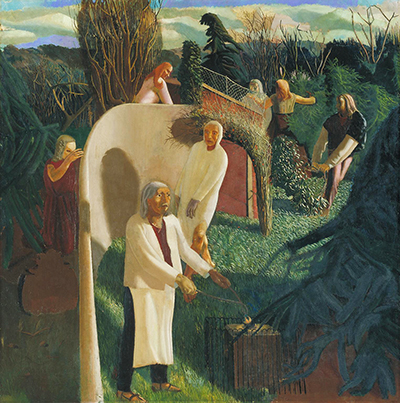Painted in oil on canvas in 1913-1914, Zacharias and Elizabeth by British artist Stanley Spencer depicts the Biblical story of the same name, which can be found in the Gospel of Luke.
In the story, the Archangel Gabriel appears to Zacharias, bringing him a message about his wife, Elizabeth. Whilst she is too old to bear children of her own, God will see to it that she shall bear one son. This son will grow up to become John the Baptist. In Zacharias and Elizabeth, Zacharias is first seen as an old man in the foreground, his greying hair flowing out behind him, his hands holding a pair of tongs over a burning flame. Zacharias then appears again in the background of the painting, whilst the Archangel Gabriel looks to approach the first Zacharias from along the curved white partition that divides them.
Elizabeth meanwhile can be seen also behind this white partition, separating her from the two figures of her husband. Her expression is hard to discern, and she is only painted from the torso up. The most striking thing that acknowledges her as Elizabeth is her bright auburn hair, which cascades past her shoulder. Another unknown woman is also present in the scene, her identity not revealed to us as she stands beside an unmarked grave. At the very rear of the scene is a man dressed as a gardener, holding an ivy branch. This ivy branch brings to mind themes of eternal life and resurrection, and this symbology is said to either make the unknown male figure representative of either John the Baptist or Jesus Christ.
Stanley Spencer trained at the Slade School of Art and found acclaim through his artist interpretations of Biblical scenes, which he painted as occurring in Cookham. Born in Cookham, a town near the Thames, Stanley Spencer lived and worked here for most of his life. His paintings, such as Zacharias and Elizabeth, would often feature multiple figures in a scene and during the Second World War, he was commissioned as part of the War Artists' Advisory Committee. His works would often provoke controversy, especially given his sensitive subject matter choices. Inspired by Gaugin and Freud, Spencer's artwork is often difficult to classify and he as an artist did not align himself to any particular style or movement. Zacharias and Elizabeth was painted early in his career, with critic Edward Marsh describing Spencer's early works as "glowing with genius".




